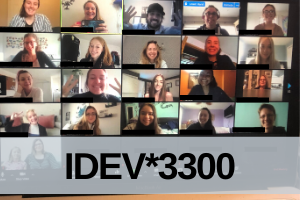Virtual Exchange - Faculty
Benefits of Virtual Exchange
- Equity – While only a small number of students are able to study abroad (travel), virtual exchange enables any/all students to have international and intercultural experiences at home in their U of G classes.
- Intercultural skills & global perspectives – VE provides an opportunity for students to have significant interactions with others who are different from them. If intercultural training is provided and time is given for reflection about intercultural interactions, meaningful intercultural learning can occur. VE can also serve as a means to internationalize the curriculum (SUNY, n.d.).
- Networking – Virtual course components give the opportunity to network with new people, outside of one's usual social media bubbles where people tend to interact with others who are like them.
- Creativity – VE offers an opportunity to be creative in addressing the new challenges of teaching online due to the current pandemic. Faculty can be inventive and innovative since there are so many different ways that virtual exchange can be done.
- Skills - VE may lead to professional development in areas of content expertise, instructional design, learning theory and information technology (Begin Caouette, 2013).
Examples of Virtual Exchange at UofG
Here are some examples of the Virtual Exchange opportunities that have been offered on our UofG campus to give you an idea of what you can do.
How to Incorporate Virtual Exchange
CIP has outlined best practices, tips and tricks, and different options for your to consider when implementating Virtual Exchange.
Getting Started with Virtual Exchange
FAQ
The Stephen Initiative Virtual Exchange Impact and Learning Report (2019) suggests that most Virtual Exchange (VE) programs share common characteristics such as, "Using videoconference for synchronous or real-time communication, sending written or recorded messages asynchronously, or some combination of both methods; connecting young people in different countries; facilitating the learning experience with trained educators; and maintaining sustained communication over weeks or months so participants can build trust and understanding" (p. 3).
Within different contexts, VE can be referred to as: Collaborative Online Intercultural Learning (COIL), Globally-Networked Learning Environments (GNLEs), Telecollaboration, E-tandem, and Global virtual teams (O'Dowd, 2018).
Components of a successful VE encompass intercultural learning outcomes, multiple interactions over a sustained period of time, a mix of synchronous and asynchronous connections, and opportunities for participants to collaborate on a joint online project (Bureau of Education and Cultural Affairs, 2019)
- VE provides an opportunity for students who may not otherwise be able to participate in a study abroad program to benefit from an intercultural learning environment without having to travel (Esche, 2018)
- Even though the experience is virtual, several researchers argue that the experience can foster intercultural competencies (Abrahamse et al., 2015; Appiah-Kubi & Annan, 2020; Bassani & Buchem, 2019; Custer & Tuominen, 2017; Lenkaitis, Calo, & Escobar, 2019; Li, 2013; Patterson, Carillo, & Salinas, 2013; Zhang & Pearlman, 2017; Zhu, Gareis, Bazzoni, & Rolland, 2005).
As SUNY (n.d) suggests, faculty members interested in VE should reflect on the following questions:
- Which aspects of your course would be enhanced if students could discuss their implications with peers in another geographic location?
- How would having multiple or different cultural perspectives enhance your students’ understanding of the course content and energize your classroom?
- Are there projects that the two student cohorts could develop together or are there photos, videos or other course-related artifacts that students could exchange and discuss cross-culturally?
Faculty members should consider the 4 T's (Time, Technology, Teams, Task when designing a VE program.
- Time: semester dates, holidays, time zones, and the time necessary to complete tasks
- Technology: synchronous and asynchronous platforms
- Teams: reciprocity and sustainability, knowledge equity, language of engagement, like learners, cross-cultural context, and sense of community
- Tasks: project-based learning, curriculum alignment, engagement, clear instructions and guidance
The Centre for International Programs has a vast network of 100+ exchange partner universities in nearly 30 countries. Within the network, several international partners have expressed interest in developing VE. Faculty interested in finding a potential partner should contact the CIP office.
Before the semester begins, Starke-Meyerring and Andrews (2006) recommends that faculty members collaborate on the following tasks:
- Determining the specific outcomes, extent, and shape of the project
- Determining goals, specifications, and scheduling of assignments
- Aligning the different grading standards and establishing the logistics of assessing student work and reporting that assessment to students
- Selecting the appropriate technologies for student collaboration
- Developing ways to help students reflect on their learning in this new environment
A VE should use a mix of synchronous (live) and asynchronous (time-delayed) technologies.
Synchronous technologies may include: Adobe Connect, Facebook Live, YouTube, Skype, and Google Hangouts.
Asynchronous technologies may include: What's App, SnapChat, Facebook and can be supplemented with email, text chats on social media (Bureau of Education and Cultural Affairs, 2019)
The Centre for International Programs has developed a course module on Intercultural Effectiveness to help students develop the intercultural competence necessary to work effectively within culturally diverse teams. Find out more about this Intercultural Competencies Course by contacting CIP.
Additional Resources
Here you can find a list of resources to help with the development of your Virtual Exchange content.


